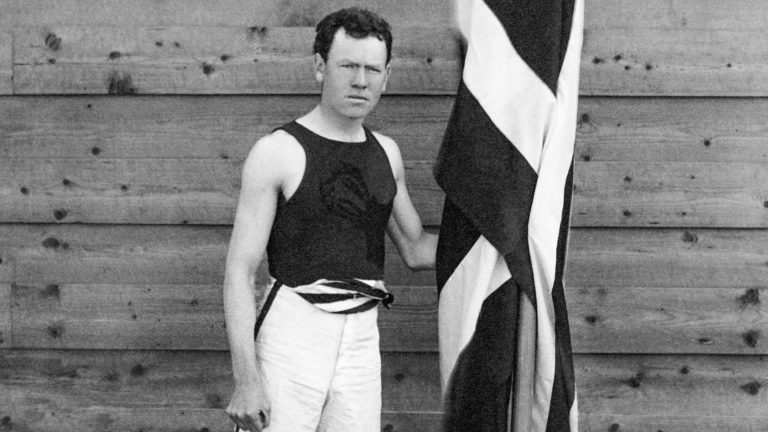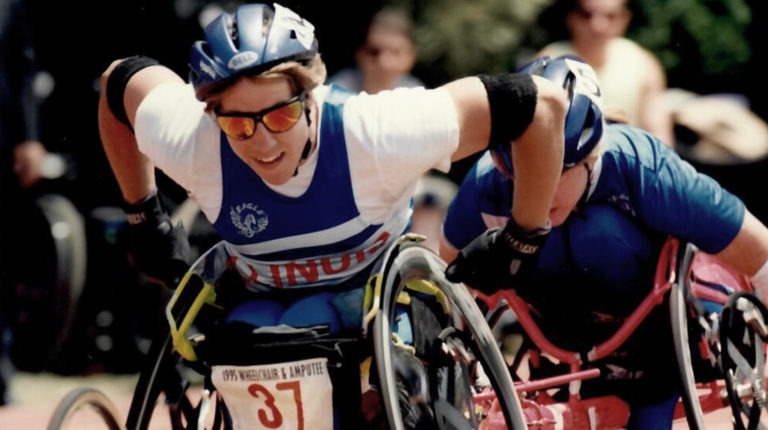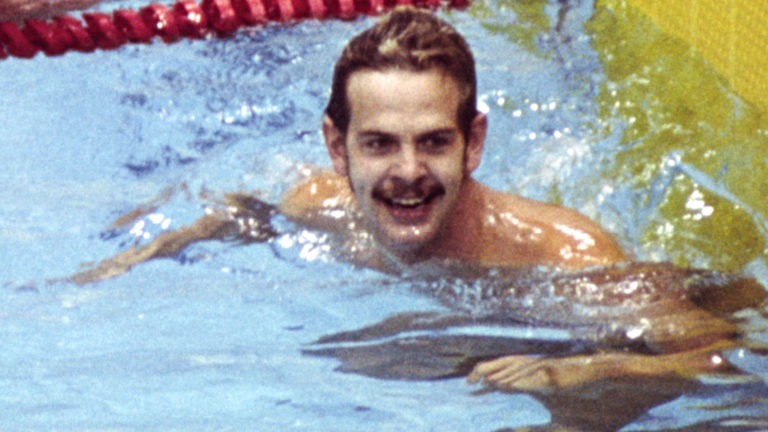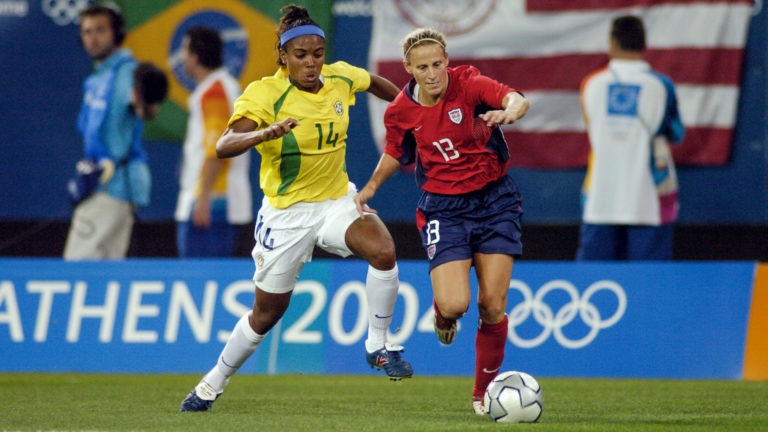
Dick Fosbury
Dick Fosbury revolutionized the high jump. After Fosbury set an Olympic record and won gold at the Mexico City 1968 Olympic Games, the “Fosbury Flop” became a staple of every high jumper.

Dick Fosbury revolutionized the high jump. After Fosbury set an Olympic record and won gold at the Mexico City 1968 Olympic Games, the “Fosbury Flop” became a staple of every high jumper.

Colonel Don Hull served in World War II and the Korean War before a career in athletic administration. He served as the executive director of the Amateur Athletic Union from 1962 to 1978, then served eight years as president of the International Amateur Boxing Association.

Swimmer Don Schollander won four gold medals at the Tokyo 1964 Olympic Games, the most by an American in a single Olympics in 28 years. He won three more in the Mexico City 1968 Olympic Games.

Donna de Varona made her Olympic debut as a 13-year-old at the Rome 1960 Olympic Games, winning a relay gold medal, and won two more gold medals at the Tokyo 1964 Olympic Games.

Dorothy Hamill inspired a generation of girls. With her bob haircut and peaceful nature, Hamill was brilliant, skating to the ladies’ singles gold medal at the Innsbruck 1976 Olympic Winter Games.

Duke Kahanamoku introduced a powerful style of swimming, winning five medals (three gold) over three Olympic Games. He then became a surfing ambassador to the world.

Ed Temple built Tennessee State University women’s track and field into a powerhouse. Forty of his athletes competed in the Olympics. He coached the 1960 and 1964 U.S. Olympic Women’s Track Teams.

Twelve years after winning a boxing gold medal, bobsledding rookie Eddie Eagan added another gold medal in his first and only bobsled race.

Edwin Moses won 122 consecutive races in the 400-meter hurdles, including two Olympic gold medals.

Eric Heiden won an unprecedented gold medals in all five distances at the Lake Placid 1980 Olympic Winter Games, from the 500-meter sprint to the grueling 10,000-meter race.

Swimmer Erin Popovich is a three-time Paralympian; 14 of her 19 Paralympic medals were golds. She is a two-time winner of the ESPY Award for Best Female Athlete with a Disability.

Evelyn Ashford won four gold medals and one silver medal while competing in four Olympic Games.

Col. F. Don Miller is regarded as one of the key figures in the development of the U.S. Olympic Committee, serving 16 years as executive director.

Flo Hyman helped lead Team USA to a silver medal at the Olympic Games Los Angeles 1984, the first Olympic medal ever won by the U.S. women’s volleyball team.

Florence Griffith Joyner was one of the most flamboyant runners of all time. Known for her long hair, long fingernails and bright track suits, FloJo won three Olympic gold medals and two silvers.

It was during his time at reform school that Floyd Patterson became interested in boxing. At 17 years old, he won an Olympic gold medal and went on to a prolific professional career.

A former member of the UCLA men’s soccer team, movie producer and director Frank Marshall was a vice president of the U.S. Olympic Committee and served on the Board of Directors and Executive Committee. He was presented the Olympic Shield in 2005 for his contributions to the Olympic and Paralympic movements.

At the Munich 1972 Olympic Games, Frank Shorter became the first American man in 64 years to win an Olympic marathon gold medal. He added a silver at the Montreal 1976 Olympic Games.

Frank Wykoff won gold medals in the 4×100-meter relay at three consecutive Olympic Games, the first athlete to accomplish that feat.

Gabby Douglas made history at the London 2012 Olympics as the first Black woman to win the all-around gymnastics title and also the first American to win all-around and team golds during the same Games.

Diagnosed with Graves’ disease, sprinter Gail Devers nearly needed her feet amputated. But she recovered to win three gold medals and competed in five Olympic Games.

Gary Hall Jr. was known for his showman-like nature and his fast speeds in the pool. Often arriving in a patriotic robe and boxing shorts, Hall won 10 Olympic medals, five gold, over three Olympic Games.

A high school dropout, George Foreman entered the Job Corps program, a decision that led him to a successful boxing career and a gold medal at the Mexico City 1968 Olympic Games.

Glenn “Jeep” Davis had blazing speed that carried him to three Olympic gold medals. Following his track career, he played two years of professional football in the NFL before becoming a track coach.

Greg Louganis became the first male diver to sweep the 3-meter springboard and 10-meter platform events at consecutive Olympics Games.

After her Olympic dream was postponed, Gretchen Fraser became the first American to win an alpine skiing medal.

One of the greatest basketball coaches of all-time, Hank Iba guided the United States men’s basketball teams to two Olympic gold medals and one silver.

Harrison “Bones” Dillard is the only man to win Olympic gold medals in the 100-meter dash and the 110-meter hurdles. In between the 1948 and 1952 Olympic Games, he served in the U.S. Army.

“Queen” Helene Madison was one of the first American female swimming stars, winning two individual gold medals and the 4×100-meter freestyle relay gold at the Los Angeles 1932 Olympic Games.

The last player cut from the 1960 U.S. Olympic Team that won gold at Squaw Valley, Herb Brooks played in the next two Olympics and was the coach of the 1980 Miracle On Ice gold-medal winning team.

Equestrian J. Michael Plumb competed in seven Olympics, more than any other American athlete, winning six medals: two gold and four silver.

Four-time Olympian Jack Kelly Jr. was selected president of the U.S. Olympic Committee in 1985, but died of a heart attack while jogging just three weeks later.

Snubbed by the elite Diamond Sculls, Jack Kelly Sr. entered the Antwerp 1920 Olympic Games just to gain a measure of revenge. He did just that, claiming gold medals in the single and double scull.

Speed skater Jack Shea in 1932 became the first American to win multiple gold medals in a single Olympic Winter Games. He was killed by a drunk driver weeks before his grandson won Olympic gold.

Jackie Joyner-Kersee won six Olympic medals (three gold) and was named the Greatest Female Athlete of the 20th Century by Sports Illustrated.

James Connolly dropped out of Harvard to participate in the first-ever modern Olympics, the Athens 1896 Olympic Games, where he placed first in the very first event, the triple jump.

James L. Easton served as president of the World Archery Federation for 16 years and was vice president of the International Olympic Committee from 2002 to 2006.

Janet Evans competed in three Olympics and won four gold medals. She will never forget passing the torch to Muhammad Ali to light the Olympic Flame at the Atlanta 1996 Olympic Games.

Jean Driscoll got into wheelchair racing in college and became a five-time Paralympic gold medalist. She won two gold medals in the marathon and also won seven consecutive Boston Marathons.

Swimmer Jenny Thompson is the most decorated American female in Olympic history, winning 12 medals over the course of four Olympic Games: eight gold, three silver and one bronze.


Broadcaster Jim McKay was well known for his coverage of the Olympics, including the Munich 1972 Olympic Games where — on his only scheduled off day during the competition — he broadcast for 16 consecutive hours without a break after the tragic killing of 11 Israeli athletes, coaches and trainers.

The first Native American to win an Olympic gold medal for the U.S., Jim Thorpe won the pentathlon and decathlon at the Stockholm 1912 Olympic Games. He later played pro baseball and football.

Joan Benoit had knee surgery 17 days before the 1984 U.S. Olympic Trials, but finished first at the Trials and won gold in the first-ever Olympic women’s marathon at the Los Angeles 1984 Olympic Games.

Joe Frazier traveled to the Tokyo 1964 Olympic Games as an alternate and took advantage when an injury gave him a spot in the heavyweight tournament, winning a gold medal.

John Carlos and Tommie Smith’s protest for racial equality has echoed throughout the sports world since the Mexico City 1968 Olympic Games.

One of the most dominant athletes of his generation, John Davis compiled a 15-year winning streak that included gold medals at the London 1948 Olympic Games and the Helsinki 1952 Olympic Games.

A competitive swimmer, John Morgan lost his eyesight as a teenager, but eventually got back in the pool to won 15 Paralympic medals, 13 of them gold.

At the Montreal 1976 Olympic Games, John Naber won four gold medals: 100- and 200-meter backstroke, 4×100-meter medley relay, 4×200-meter freestyle relay — all in world-record time.

Johnny Weissmuller took up swimming in an attempt to build stamina after contracting polio as a youngster. He won five Olympic gold medals before finding Hollywood stardom.

Karch Kiraly led the U.S. to two men’s volleyball gold medals, won a gold medal in beach volleyball and coached the U.S. Women’s Volleyball Team to a bronze medal at the Rio je Janeiro 2016 Olympic Games.

Kerri Walsh Jennings redefined excellence in the sport of beach volleyball, winning three consecutive gold medals (2004, 2008, 2012) and a bronze in 2016.

A three-time Big Ten Conference champion while attending Michigan State University, Australian Kevan Gosper made his Olympic debut at the Melbourne 1956 Olympic Games, helping Australia win the silver medal

Kristi Yamaguchi won the ladies’ singles figure skating gold medal at the Albertville 1992 Olympic Winter Games.

Kristine Lilly played 354 games in a U.S. uniform and won two Olympic gold medals and one silver. Lilly scored goals in three consecutive games at the Athens 2004 Olympic Games.

Lee Calhoun was the first male athlete to win consecutive Olympics gold medals in the 110-meter hurdles, winning photo finishes at the Melbourne 1956 Olympic Games and Rome 1960 Olympic Games.

A founding member of the Olympic Project for Human Rights, Lee Evans (center) won gold medals in the 400-meter run and the 4×400-meter relay at the Mexico City 1968 Olympic Games.

LeRoy Walker was the first Black American to coach a U.S. Olympic Team, guiding the men’s track and field team to six gold medals in the Montreal 1976 Olympics.

Lindsey Vonn is considered one of the greatest Olympic ski racers. She is the only American woman to win an Olympic downhill gold and grab four world cup overall titles.

Discover Olympic legend Lisa Fernandez, a U.S. softball player with a 25-strikeout Olympic record, .545 batting average, and 3 consecutive Olympic gold medals.